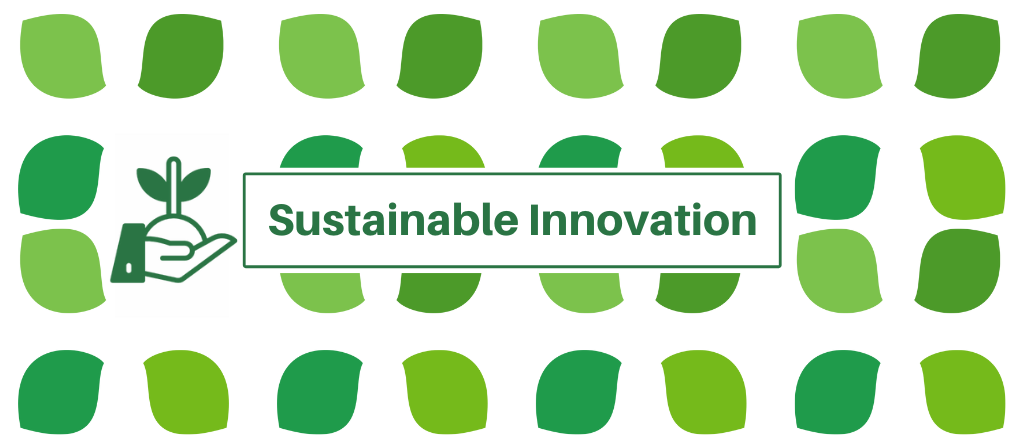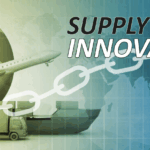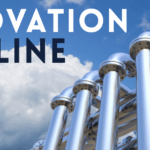What is Sustainable Innovation?
Sustainable innovation is the application of new ideas to create value while prioritizing benefits for both people and the planet.
Professor Rajesh Chandy, a Professor at the London Business School, breaks down Sustainable Innovation into its component parts.
What is Innovation? The application of a new idea to create value.
Sustainability? This involves creating value for people and the planet.
The world faces serious environmental, economic, and social challenges. It is the job of corporations, government, regulators, and individuals to meet the legitimate aspirations of the world’s population in a way that the earth and society can bear and that will also allow the planet and society to flourish.
This dual focus on innovation and sustainability isn’t new. In fact, the concept of the “triple bottom line”—people, planet, and profit—was first articulated by John Elkington in the 1990s. Elkington’s framework challenged businesses to go beyond short-term financial gain and consider their environmental and social responsibilities as core to long-term success. Sustainable innovation, therefore, is not just about developing the next big product or process, but ensuring that these developments generate value across all three dimensions.
By integrating new ideas with environmental stewardship and social impact, sustainable innovation encourages organizations to rethink traditional business strategies. The goal: create solutions that drive economic growth while preserving resources and uplifting communities—now and for future generations.
The UN’s Sustainability goals are broader and more ambitious than any one country or company. The complexity of the issues facing the world in 2025 are not solvable by a superficial fix, long term sustainable solutions are required, including collaboration and inclusion with local communities and harnessing the latest disruptive technologies.
Alternative Terms for Sustainable Innovation
When talking about sustainable innovation, you might also encounter terms such as eco-innovation, green innovation, sustainable solutions, or sustainable development. These phrases are often used interchangeably to describe the process of developing new ideas that generate value–not just for business, but also for society and the environment.
How Sustainable Development is Defined
To put it simply, sustainable development is about meeting today’s needs without putting tomorrow at risk. As articulated by the Brundtland Commission back in 1987, this concept centers on progress that doesn’t deplete resources or opportunities for future generations. In other words, it’s future-focused growth—balancing what we need now with what the planet and society will require for years to come.
Key Frameworks and Approaches to Sustainable Innovation
To better understand sustainable innovation, it’s helpful to explore some of the foundational frameworks that have shaped how experts approach this topic.
One of the earliest and most influential definitions of sustainability comes from the 1987 Brundtland Report, which outlined sustainable development as “meeting the needs of the present without compromising the ability of future generations to meet their own needs.” This guiding principle continues to underpin modern sustainability thinking and strategy.
Building on this, John Elkington introduced the “Triple Bottom Line” (3P) model in the 1990s—a framework now widely adopted by organizations worldwide. The Triple Bottom Line encourages companies to look beyond just profit and consider:
- People: Focusing on the social impacts and wellbeing of employees, communities, and broader society.
- Planet: Addressing environmental stewardship, resource efficiency, and minimizing ecological footprints.
- Profit: Ensuring long-term economic viability alongside social and environmental responsibility.
By balancing these three dimensions, businesses and policymakers can drive innovation that is not only profitable but also socially just and environmentally sound.
These frameworks, alongside more recent approaches like circular economy principles and the UN’s Sustainable Development Goals, act as roadmaps for organizations committed to meaningful, long-term progress. Sustainable innovation isn’t just about technology or efficiency—it’s about adopting holistic strategies that set the stage for enduring value for people, the planet, and future generations.
Business Models and Evolving Research in Sustainable Innovation
Sustainable innovation isn’t just about inventing eco-friendly products—it’s about redesigning the very models businesses use to create and deliver value. Existing approaches have moved beyond classic “take-make-waste” to embrace circular economies, shared value, and regenerative systems. These business models reimagine how resources circulate, prioritize longevity over disposability, and build collaboration into their DNA.
Key trends in the current research agenda include:
- Circular Economy Models: Encouraging companies to reuse, refurbish, and recycle, rather than extract and dispose. Think of the strategies behind Patagonia’s recycled gear or IKEA‘s furniture take-back programs.
- Product-Service Systems: Shifting focus from selling more “stuff” to delivering services or access. For example, Philips offering “lighting as a service” reduces waste and aligns incentives around product longevity and efficiency.
- Collaborative Platforms: Harnessing the power of networks—whether it’s through open innovation platforms or partnerships with NGOs, startups, and local communities—to unlock new sustainable solutions.
- Inclusive Value Creation: Rethinking who benefits, by ensuring that innovation leads to shared prosperity across the value chain, not just for shareholders.
On the research front, scholars and practitioners are examining:
- How to effectively embed sustainability in traditional and new business models,
- Tools for measuring both environmental and social impact,
- The critical conditions and incentives needed to scale sustainable innovation across industries.
Ultimately, businesses that innovate for sustainability are not just responding to regulations or reputational risk—they are setting the agenda, redefining profitability, and paving the way for resilient growth.
Frameworks for Understanding Sustainable Innovation Through Stakeholder Involvement
Tackling sustainable innovation requires more than just creative thinking—it demands active involvement from a variety of stakeholders. One widely recognized approach highlights the importance of engaging all parties who are impacted by, or can influence, innovation, from local communities and government agencies to private sector partners and advocacy groups.
A solid framework for making sense of this process is built around:
- Identifying Stakeholders: Start by mapping out everyone affected, including internal teams, customers, suppliers, regulators, and even those who might initially be overlooked.
- Inclusion at Every Stage: Involve diverse stakeholders early and often—from ideation to implementation—ensuring every voice is heard and considered.
- Collaboration and Co-Creation: Foster partnerships that enable joint problem-solving and resource sharing, making the solution stronger and more resilient.
- Feedback Loops: Create mechanisms for continual input and adaptation, allowing the innovation process to stay flexible and responsive to new insights.
By following an inclusive framework that prioritizes meaningful stakeholder engagement, organizations are better equipped to design sustainable solutions that actually work—in the real world, and for the long haul.
Concepts and Applications of Responsible Innovation
Responsible innovation goes beyond simply inventing new products or processes—it asks us to consider not just “Can we?” but also “Should we?” At its core, responsible innovation integrates ethical reflection, stakeholder engagement, and anticipation of broader impacts throughout the innovation process.
Key concepts include:
- Inclusivity: Engaging a diverse range of stakeholders, including local communities, end users, and regulatory bodies, to ensure new solutions are beneficial for all.
- Ethical Foresight: Assessing possible long-term social, environmental, and ethical consequences before rolling out new ideas or technologies.
- Adaptability: Ensuring that products and systems can evolve in response to societal needs, regulatory developments, and feedback from affected communities.
- Transparency: Communicating openly about intentions, processes, and trade-offs with all stakeholders involved.
Applications in practice can look like:
- Collaborating with NGOs, industry partners, and local governments to co-develop clean energy solutions that not only reduce emissions but also create jobs.
- Setting up independent ethics boards to guide the development of artificial intelligence or biotech innovations.
- Involving customers in the design phase through participatory workshops or pilot programs, so that products align with real-world needs and values.
In short, responsible innovation calls for a holistic, participatory approach—making sure the drive for progress aligns with our collective well-being and the health of the planet.
Concepts and Applications of Responsible Innovation
Responsible innovation goes beyond simply inventing new products or processes—it asks us to consider not just “Can we?” but also “Should we?” At its core, responsible innovation integrates ethical reflection, stakeholder engagement, and anticipation of broader impacts throughout the innovation process.
Key concepts include:
- Inclusivity: Engaging a diverse range of stakeholders, including local communities, end users, and regulatory bodies, to ensure new solutions are beneficial for all.
- Ethical Foresight: Assessing possible long-term social, environmental, and ethical consequences before rolling out new ideas or technologies.
- Adaptability: Ensuring that products and systems can evolve in response to societal needs, regulatory developments, and feedback from affected communities.
- Transparency: Communicating openly about intentions, processes, and trade-offs with all stakeholders involved.
Applications in practice can look like:
- Collaborating with NGOs, industry partners, and local governments to co-develop clean energy solutions that not only reduce emissions but also create jobs.
- Setting up independent ethics boards to guide the development of artificial intelligence or biotech innovations.
- Involving customers in the design phase through participatory workshops or pilot programs, so that products align with real-world needs and values.
In short, responsible innovation calls for a holistic, participatory approach—making sure the drive for progress aligns with our collective well-being and the health of the planet.
The Role of Business Models in Capturing Value from Innovation
When it comes to sustainable innovation, having a great idea is only half the equation. The real challenge—and opportunity—lies in figuring out how to actually turn that idea into tangible value. This is where business models step into the spotlight.
A business model outlines how an organization creates, delivers, and captures value. It serves as the blueprint that connects innovative products or services to customers, channels, partners, and revenue streams. Think of it as the engine under the hood, making sure all the creative horsepower gets efficiently translated into impact and returns.
Without a robust business model, even ground-breaking solutions can stall before they make any meaningful difference. Successful innovators—from global corporations to ambitious startups—put careful thought into designing their business models so they can unlock value, stay scalable, and adapt to market changes. This not only helps bring sustainable ideas to market but also makes them viable in the long run.
Next up: let’s look at how cutting-edge technology and entrepreneurial thinking are helping turn sustainable innovation from a buzzword into real-world progress.
Key Insights from Systematic Reviews on Sustainable Innovation
So, what does the current research landscape say about sustainable innovation? Systematic literature reviews, like the thorough analysis by Cillo and colleagues, highlight a few central themes:
- Integration Is Essential: Sustainable innovation isn’t just about inventing eco-friendly products or processes. True impact requires weaving sustainability principles into the strategy, operations, and culture of organizations. This means thinking beyond isolated projects—embracing a holistic, long-term approach.
- Collaboration Drives Progress: Research points to the importance of partnerships between businesses, governments, and local communities. These collaborative efforts enable diverse perspectives, shared resources, and the ability to address sustainability from multiple angles.
- Barriers and Enablers: The reviews identify frequent roadblocks—like limited financial resources, short-term mindsets, and regulatory complexity. On the other hand, enablers include clear leadership commitment, supportive policy environments, and a willingness to experiment and learn from failure.
- Measurable Value: Successful sustainable innovation generates value not only for companies but also for society and the environment. The literature stresses the need for robust systems to track ecological, social, and economic outcomes—ensuring progress is tangible, not just theoretical.
In short, the academic consensus echoes what leading innovators already know: sustainable innovation flourishes in open, collaborative, and purpose-driven environments where impact is tracked and celebrated.
What Drives Eco-Innovations in Different National Contexts?
The forces behind eco-innovation can differ wildly depending on where you are in the world. In the UK, for instance, research suggests that a blend of regulation, market demand, and corporate leadership are significant motivators. But the story doesn’t end there.
- Government Policies and Regulations: Strong environmental standards and incentives—think tax breaks or emission limits—often nudge companies to prioritize eco-friendly solutions.
- Market Demand: As consumers grow savvier and more environmentally conscious, their preferences push businesses to develop greener products and services.
- Corporate Commitment: Leadership that values sustainability can set an example, encouraging a culture where innovation naturally aligns with environmental goals.
- Access to Technology and Knowledge: Countries with better access to research institutions, skilled talent, and emerging tech tend to see faster adoption of eco-innovations.
- Availability of Resources: Financial backing, whether from investors, the public sector, or NGOs, enables organizations to experiment and scale sustainable ideas.
Local context matters—a solution driven by consumer activism in London might stem from compliance in Tokyo or government support in Berlin. Yet, whether prompted by stick (regulation), carrot (incentives), or a groundswell of public sentiment, the journey toward sustainable innovation reflects the unique challenges and opportunities in each region.
Key Determinants of Environmental Innovation
So, what actually drives the development of environmentally-friendly innovations in practice? Empirical studies—including major research from Germany—highlight several key factors that play a pivotal role:
- Regulation and Policy: Strong environmental regulations and government incentives often prompt companies to seek innovative solutions, whether through cleaner technologies or sustainable business models.
- Market Demand: When customers start caring more about sustainability, businesses notice. Growing demand from environmentally conscious consumers encourages companies to innovate and differentiate themselves through greener offerings.
- Pressure from Stakeholders: Investors, NGOs, and local communities can all influence organizations to adopt innovative practices that reduce their environmental footprint.
- Internal Capabilities: Firms with robust research and development resources, skilled employees, and a culture that values sustainability are better equipped to implement environmental innovations.
- Collaboration: Working closely with universities, research institutes, and even competitors can accelerate green innovation by sharing knowledge, risks, and rewards.
Together, these factors not only drive companies to comply with standards but also motivate them to lead on sustainability—often finding competitive advantages along the way.
Dimensions and Structure of Eco-Innovation
When discussing sustainable innovation, it’s essential to look beneath the surface and understand the dimensions that make eco-innovation possible and impactful. Eco-innovation is not a one-size-fits-all concept; instead, it’s comprised of multiple layers that each play a pivotal role in driving meaningful change.
At its core, eco-innovation incorporates:
- Environmental Impact: Solutions must focus on reducing resource consumption, decreasing waste, and minimizing pollution. For example, innovations in renewable energy or circular economy models target these key environmental touchpoints.
- Technological Advancement: Progress is fueled by novel technologies—think solar panels, biodegradable packaging, and AI-driven recycling systems—that disrupt traditional models and move us toward greener outcomes.
- Organizational Change: True eco-innovation requires shifts in how organizations operate. This could be adopting new business models, rethinking supply chains, or embedding sustainability into company culture and decision-making.
- Social and Regulatory Considerations: No innovation exists in a vacuum. Collaboration with regulatory bodies, alignment with international standards (like those promoted by the UN and EU), and engagement with local communities are all vital to successful eco-innovation.
By embracing these interconnected dimensions—environmental, technological, organizational, and social—organizations can structure their sustainability efforts in a way that’s both comprehensive and scalable. It’s a holistic approach, blending bold ideas with pragmatic action, ensuring innovation benefits people and the planet for the long term.
Why Sustainability Assessment Matters in Innovation
Sustainability assessment acts as a vital tool in the innovation process by helping organizations evaluate the broader impacts of their ideas—not just the profit potential, but also the effects on people and the planet. With this structured approach, innovators can ensure that new products, services, or processes deliver long-term value without causing unintended harm to communities or ecosystems.
By integrating sustainability assessment at key stages, teams can:
- Identify and address potential environmental and social risks before they escalate.
- Measure outcomes against sustainability benchmarks, such as the UN’s Sustainable Development Goals.
- Encourage responsible resource use, support circular economy practices, and safeguard biodiversity.
- Build trust with stakeholders and consumers who are increasingly demanding ethical and eco-friendly solutions.
In essence, sustainability assessment enables a balanced approach to progress—fueling bold ideas while making sure that growth stays in harmony with the world around us.
Key Elements of a Practical Sustainability Assessment
Achieving true sustainable innovation isn’t just about setting lofty goals; it requires a grounded approach to measuring real environmental and social impact. So, what does a practical sustainability assessment actually involve? Here are the essentials:
- Clear Objectives: Start with well-defined sustainability goals that consider both short-term value and long-term impact for people and the planet.
- Holistic Criteria: Evaluate not only economic benefits, but also environmental, social, and ethical dimensions to ensure a balanced perspective.
- Stakeholder Engagement: Involve everyone affected—from communities to customers—to create solutions that are inclusive and relevant.
- Transparent Methods: Use transparent, data-driven tools and frameworks that allow others to understand and verify your process.
- Adaptability: Make assessment a living process, revisiting your criteria and measurements as challenges and technologies evolve.
- Continuous Improvement: Prioritize learning and iteration—sustainability isn’t a one-and-done achievement but an ongoing commitment.
By focusing on these components, organizations create a strong foundation for meaningful, measurable progress toward sustainability.
Key Elements of a Practical Sustainability Assessment
Achieving true sustainable innovation isn’t just about setting lofty goals; it requires a grounded approach to measuring real environmental and social impact. So, what does a practical sustainability assessment actually involve? Here are the essentials:
- Clear Objectives: Start with well-defined sustainability goals that consider both short-term value and long-term impact for people and the planet.
- Holistic Criteria: Evaluate not only economic benefits, but also environmental, social, and ethical dimensions to ensure a balanced perspective.
- Stakeholder Engagement: Involve everyone affected—from communities to customers—to create solutions that are inclusive and relevant.
- Transparent Methods: Use transparent, data-driven tools and frameworks that allow others to understand and verify your process.
- Adaptability: Make assessment a living process, revisiting your criteria and measurements as challenges and technologies evolve.
- Continuous Improvement: Prioritize learning and iteration—sustainability isn’t a one-and-done achievement but an ongoing commitment.
By focusing on these components, organizations create a strong foundation for meaningful, measurable progress toward sustainability.
Environmental Innovation and R&D Collaboration: A Spanish Case Study
To truly make strides in sustainability, teamwork isn’t just helpful—it’s essential. Research focusing on Spanish manufacturing industries reveals a clear trend: companies that join forces through R&D partnerships tend to achieve greater advancements in environmental innovation. Whether it’s cutting carbon emissions, developing eco-friendly materials, or rethinking energy use, firms collaborating on research and development share diverse knowledge, mitigate risks, and accelerate creative problem-solving.
It turns out, when businesses pool their resources and expertise, the result isn’t just incremental progress—it’s often transformative. By cooperating on R&D, these organizations not only push the boundaries of what’s possible but also set new benchmarks for environmentally responsible practices across the sector.
Measuring and Interpreting Sustainable Innovation
So, how do organizations actually measure and interpret innovation—especially when sustainability is at the heart of the mission? Thankfully, we’re not completely in the wild west here. Industry experts often turn to recognized frameworks, such as those outlined in the Oslo Manual by the OECD and Eurostat. This manual lays out practical guidelines on how to collect, analyze, and compare innovation data, ensuring that efforts toward sustainability are not just aspirational, but trackable and transparent.
Key components include:
- Clear definitions: Establishing what counts as an innovative activity and figuring out how it delivers value for people and the planet.
- Data collection: Leveraging surveys and qualitative insights from companies, governments, and communities to get a holistic view.
- Impact assessment: Moving beyond output (like number of patents) to measure social, economic, and environmental effects.
- International benchmarks: Comparing progress across regions and sectors, so best practices can be shared and scaled.
Adopting these established methodologies helps organizations identify not only what’s working, but also where innovation gaps remain—crucial steps for building initiatives that truly advance sustainable outcomes.
Key Concepts in Frontline Innovation Management
Frontline innovation management is all about actively engaging those closest to the work—the people on the ground—in the innovation process. Unlike traditional top-down approaches, this method empowers frontline employees to contribute ideas, experiment with new processes, and drive change where it matters most.
Core principles include:
- Decentralized Decision-Making: Encouraging teams and individuals to identify opportunities and implement solutions quickly, without waiting for extensive managerial approval.
- Iterative Experimentation: Supporting small-scale trials and rapid prototyping, so that failures are learning opportunities rather than setbacks.
- Continuous Feedback: Fostering an open environment where feedback from frontline staff is not only welcomed but systematically integrated into the innovation cycle.
- Cross-Functional Collaboration: Bridging gaps between departments or expertise areas—think engineers working closely with marketing, or operations partnering with sustainability teams.
- Leadership Support: While the frontline takes the lead in generating ideas, robust support from leadership ensures that efforts are resourced, recognized, and scaled when successful.
By putting innovation tools in the hands of those who understand daily challenges best, organizations can achieve more relevant, sustainable, and impactful outcomes.
Types and Terminologies of Technological Innovation
To better understand sustainable innovation, it’s helpful to recognize the different types of technological innovation and the language used to describe them. Broadly speaking, innovations can be categorized based on their impact and novelty. Here’s a simplified breakdown:
- Incremental Innovation: Small, continuous improvements to existing products, services, or processes. Think of routine product upgrades from companies like Apple or Toyota—each version a little better than the last, but not radically different.
- Radical (or Disruptive) Innovation: Major breakthroughs that fundamentally change industries, markets, or business models. The introduction of the smartphone, the rise of electric vehicles like Tesla, or cloud computing are powerful examples.
- Modular Innovation: Changes to one or more components without altering the underlying system. Swapping out fossil fuel engines for electric motors in cars, while retaining car design, demonstrates this type.
- Architectural Innovation: Reconfiguring existing technologies in a novel way, which creates new markets or revamps existing ones. For instance, streaming platforms such as Netflix reimagined the way we consume media by using established internet technologies differently.
When discussing innovativeness, you’ll also encounter terms like “product innovation” (new or improved goods/services), “process innovation” (enhancements in production or delivery methods), and “business model innovation” (rethinking how value is delivered and captured).
Understanding these categories helps organizations match their approach to sustainable innovation goals: sometimes it’s about bold leaps, and other times, steady, meaningful improvements.
How Institutional Pressures Shape Environmental Management
Institutional pressures—think government regulations, industry standards, consumer expectations, and even investor scrutiny—play a significant role in shaping how organizations address environmental challenges. These external forces can nudge, or sometimes even push, companies to adopt better environmental management practices.
When stakeholders such as regulatory bodies, advocacy groups, or customers demand greater accountability, businesses often respond by implementing more robust policies around resource management, emissions, waste reduction, and sustainability reporting. For example:
- Regulatory requirements might prompt a manufacturer to overhaul their processes to meet stricter pollution controls.
- Competitive pressures within an industry can lead to companies benchmarking their sustainability practices against market leaders like Patagonia or IKEA, spurring sector-wide improvements.
- Consumer awareness—with individuals increasingly seeking greener products—can motivate brands to adopt certifications, transparently source materials, and reduce their carbon footprints.
Ultimately, these pressures don’t just encourage compliance—they drive innovation, pushing organizations to find new ways to minimize their environmental impact while still delivering value to customers and shareholders alike.
Key Academic and Industry References on Sustainable Innovation
For those seeking a deeper understanding or a solid theoretical foundation in sustainable innovation, a wealth of research and literature is available from both academia and industry. Here are some of the central references that have shaped the field and continue to guide thought leaders, policy makers, and practitioners:
- Foundational Concepts: The Brundtland Commission’s landmark report, Our Common Future (1987), remains a cornerstone, introducing the concept of sustainable development as meeting “the needs of the present without compromising the ability of future generations to meet their own needs.”
- Triple Bottom Line: John Elkington’s work from the 1990s, including Cannibals with Forks, put forward the ‘triple bottom line’—focusing on people, planet, and profit—a framework widely adopted in corporate sustainability strategies.
- Business Model Innovation: Boons and Lüdeke-Freund have explored how innovative business models can promote sustainability, while Chesbrough’s research on open innovation offers insight into leveraging external knowledge to create sustainable value.
- Corporate Social Responsibility (CSR): Numerous studies investigate the interplay between responsible business practices and innovation, highlighting how companies can drive social and environmental value while maintaining competitive advantage.
- Eco-Innovation and Environmental Management: Carrillo-Hermosilla, Del Río, and Könnölä discuss the diversity of eco-innovations, ranging from improved production processes to entirely new product-service systems. The OECD‘s manuals and reports provide practical guidance for measuring and supporting eco-innovation in industry.
- Stakeholder Engagement and Collaboration: Achterkamp and Vos, among others, emphasize the importance of involving stakeholders—including local communities and supply chain partners—in designing and implementing sustainable innovations that have lasting impact.
- Small and Medium Enterprises (SMEs): Research by Bos-Brouwers and Klewitz & Hansen highlights specific challenges and opportunities for SMEs embarking on the journey toward sustainability-oriented innovation.
- Policy and Regulation: International agencies like the United Nations (through their Sustainability Goals) and the OECD offer guidelines, frameworks, and policy recommendations that help shape national and corporate approaches to sustainable innovation.
- Emerging Topics: Recent studies have delved into areas like the role of digital transformation (Open Innovation 4.0), institutional pressures, and the effects of government incentives on university-industry partnerships for sustainability.
For a more comprehensive exploration, academic journals such as the Journal of Cleaner Production, Corporate Social Responsibility and Environmental Management, and Research Policy regularly publish cutting-edge research and case studies. These references serve as a strong foundation for anyone aiming to design, implement, or study sustainable innovation in today’s fast-evolving landscape.
Motivations Behind Sustainability in Higher Education, Research, and Practice
What drives students, researchers, and professionals to contribute to sustainability efforts in universities and beyond? According to recent studies, several key motivations stand out:
- Personal Values and Ethics
Many participants feel a strong sense of responsibility toward people and the planet. This commitment to ethical principles often sparks engagement with sustainability initiatives. - Desire for Societal Impact
There’s genuine ambition to make a meaningful difference in the world. Whether it’s contributing to climate solutions, supporting local communities, or advocating for social justice, individuals are inspired by the opportunity to create lasting positive change. - Professional Development
As businesses, governments, and organizations increasingly prioritize sustainable practices, acquiring skills and experience in this area offers powerful career advantages. Individuals recognize that sustainability expertise opens doors across industries. - Collaboration and Community
Engagement in sustainability often comes through collaborative projects, interdisciplinary research, and local partnerships. The chance to work with like-minded peers and community members is a strong, motivating factor. - Curiosity and Academic Challenge
Finally, exploring complex, interconnected problems appeals to researchers and students alike. Sustainability presents a field where innovation and creative problem-solving are not just encouraged—they’re needed.
When these motivations come together in academic settings, they help fuel the kind of sustainable innovation our world so urgently requires.
Harnessing the Latest Technologies & Entrepreneurship to Drive Sustainability
The Food and Agricultural Organization (FAO) reports that, since 2020, approximately 420 million hectares of forest have been lost to deforestation. Global tree cover continues to reduce, contributing to an estimated 4.1 gigatons of annual carbon emissions. This has severe implications for climate change since trees play such a critical role, both as a carbon sink and as protection during climate disasters.
The London Business School, Columbia University, and Iowa State initiated a project to encourage communities to plant more trees to reduce the effects of deforestation in India. The female entrepreneurs at Dharma Life in Uttarakhand, India will sell saplings in villages using the latest technology. AI-created marketing content will be utilized and communicated via the WhatsApp messaging app as cell phone use is ubiquitous in India. The project will also employ the latest generative AI tools to transform the interventions into various communication forms like videos and localized images. A mobile app-based geo-tagged tracking mechanism will be used to monitor tree growth and survival rates. At the back end, all tree-related data will be recorded on a block chain infrastructure to ensure accurate tracking.
How Can We Effectively Measure Sustainable Development?
Measuring sustainable development is no easy feat—it requires a holistic approach that captures both the progress we’re making and the challenges we still face. For organizations, policymakers, and communities, tracking sustainable development means keeping an eye on key indicators that reflect environmental health, social equity, and economic well-being.
Some common metrics include:
- Carbon footprint and greenhouse gas emissions: Monitoring how much CO₂ and other greenhouse gases are produced to identify areas for improvement.
- Resource consumption: Evaluating water use, energy consumption, and materials sourcing to ensure resources are being managed responsibly.
- Biodiversity and ecosystem health: Tracking the preservation and restoration of habitats, as well as the diversity of plant and animal life.
- Social impact: Measuring access to education, healthcare, fair wages, and community well-being.
- Economic inclusivity: Looking at indicators like job creation, income distribution, and support for local economies.
International frameworks, such as the United Nations Sustainable Development Goals (SDGs), offer a blueprint with clear targets and indicators that can be adapted for different regions and sectors. Combining quantitative data with qualitative insights from local communities ensures that sustainable development efforts are both measurable and meaningful.
Tools like impact assessments, environmental audits, and independent certifications (such as those from the Global Reporting Initiative or B Corp) can provide organizations with benchmarks, helping keep progress transparent and accountable, while also highlighting areas that need more innovation.
By using a variety of measures and embracing collaboration between sectors, we can ensure that our strategies for sustainable development are not just well-intentioned, but genuinely effective—and capable of creating lasting value for both people and the planet.

Open Innovation as a Catalyst for Sustainable Innovation Ecosystems
Open innovation has become an essential ingredient in building truly sustainable innovation ecosystems. By encouraging organizations to look beyond their internal resources and actively collaborate with external partners—such as startups, research institutions, NGOs, and even customers—open innovation accelerates the flow of new ideas, technologies, and practices.
This collaborative approach helps to:
- Break down traditional silos: Organizations can leverage diverse perspectives, reducing blind spots and uncovering solutions that may otherwise go unnoticed.
- Share risks and resources: Tackling sustainability challenges often demands substantial investment and expertise. By sharing risks, costs, and knowledge, partners can take on more ambitious projects than would be possible alone.
- Foster rapid experimentation and scaling: When multiple stakeholders pool their resources, promising ideas can move more quickly from pilot stages to broader adoption, amplifying positive environmental and social impacts.
- Enable local adaptation: Collaboration with local communities and innovators ensures that solutions are tailored for real-world impact rather than one-size-fits-all fixes.
For example, companies like Unilever and Procter & Gamble have embraced open innovation platforms to co-create sustainable packaging solutions with startups and suppliers. These efforts go beyond “not invented here” mindsets, unlocking new pathways to greener products and services.
By weaving openness, collaboration, and shared value creation into the fabric of innovation ecosystems, organizations can accelerate progress toward sustainability goals—ensuring both people and planet benefit in the long run.
Integrating Sustainable Development into Existing Management Systems
Sustainable development doesn’t require reinventing the wheel; rather, it’s about weaving responsible practices into frameworks organizations already use. The process often starts by reviewing current management systems—such as ISO 9001 for quality or ISO 14001 for environmental management—and identifying overlaps where sustainability goals can align with existing protocols.
Some practical steps include:
- Setting Measurable Objectives: Define specific sustainability targets within current performance indicators. This might mean reducing energy consumption, minimizing waste, or improving supply chain transparency.
- Employee Training and Engagement: Educate teams at every level about sustainability’s importance and demonstrate how day-to-day decisions contribute to broader goals. Even a small policy tweak can inspire more eco-friendly purchasing or production habits.
- Continuous Improvement: Use established feedback loops (like Plan-Do-Check-Act cycles) to monitor progress and refine sustainability initiatives over time. Companies that tie their sustainability aspirations directly to routine audits and management reviews often see the best results.
- Stakeholder Involvement: Invite input from employees, suppliers, and community members to ensure sustainability efforts are realistic, inclusive, and impactful. This collaborative approach not only generates fresh ideas but also builds buy-in across the organization.
By embedding these practices into their existing management structures, organizations can accelerate progress toward sustainable development—without sacrificing operational efficiency or creating unnecessary complexity.
Sustainability-Oriented Innovation in SMEs
A wealth of research has explored how small and medium-sized enterprises (SMEs) approach sustainable innovation. Systematic reviews point out that SMEs often face unique resource constraints yet remain pivotal in driving sustainability at a grassroots level. Rather than relying only on large-scale technological breakthroughs, SMEs frequently harness incremental innovations, adjusting existing processes, supply chains, and products to reduce environmental impact.
Some consistent threads from recent studies include:
- Drivers of Sustainable Innovation: Market demand, regulatory requirements, and stakeholder pressure are primary motivators for SMEs seeking sustainable solutions.
- Barriers to Adoption: Limited financial and human resources, lack of know-how, and unclear economic returns can slow progress for SMEs compared to larger corporations.
- Opportunities for Collaboration: Partnerships—with NGOs, research institutes, or supply chain partners—can be vital for accessing cutting-edge knowledge and sharing innovation costs.
- Competitive Advantage: SMEs that successfully embed sustainability into their business models often stand out to eco-conscious consumers, opening doors to new markets and enhancing brand loyalty.
- Continuous Learning: An ongoing commitment to employee education is crucial for fostering a culture of sustainability and keeping up with evolving best practices.
Systematic reviews ultimately highlight that while the road to sustainability may look different for SMEs than for multinational giants, their agility and close community ties allow them to be surprisingly effective innovators and early adopters in the sustainability landscape.
The Diversity of Eco-Innovations: Insights from Real-World Examples
Sustainable innovation doesn’t follow a one-size-fits-all approach. In practice, eco-innovations span a rich spectrum, from incremental tweaks to disruptive breakthroughs, all while targeting environmental impact across different sectors.
Eco-innovation diversity typically emerges in several ways:
- Product Redesigns: Many companies focus on lowering environmental footprints by reimagining everyday products. Biodegradable packaging, recyclable materials, and energy-efficient appliances are prime examples showing how modest changes can yield substantial benefits.
- Process Innovations: Improvements in manufacturing processes—like using renewable energy or cutting water usage—underscores how sustainability can be embedded behind the scenes. Think about major automakers optimizing production lines to minimize waste, or beverage companies developing closed-loop water systems.
- Business Model Shifts: Innovative business models also drive sustainability. Circular economy models, such as rental or product-as-a-service concepts (think: clothing rental platforms or subscription-based furniture), are gaining traction across industries.
- Systemic Solutions: Some eco-innovations address environmental challenges at the system level, tying together multiple stakeholders. Examples include collaborative supply chains focused on responsible sourcing, or citywide green infrastructure projects.
What unites these diverse efforts is a commitment to both planet and profit—demonstrating that eco-innovation can take many shapes depending on technological opportunities, regulatory environments, and customer demands.
The Role of Government Subsidies in University-Industry Collaboration
Government subsidies can play a crucial role in driving sustainable innovation, particularly when universities and industries join forces. These financial incentives help lower the barriers to research and development, enabling academic researchers and industry practitioners to collaborate on solutions that benefit both the economy and the environment.
When appropriately structured, government subsidies encourage:
- The formation of long-term partnerships between universities and private companies.
- The sharing of expertise, equipment, and resources that might otherwise be out of reach for either party alone.
- The acceleration of new technologies that address sustainability challenges—think cleaner manufacturing processes, eco-friendly materials, or energy-efficient systems.
Moreover, subsidies often promote risk-taking and experimentation that would be financially daunting for organizations acting alone. By absorbing part of the cost, governments empower teams to pursue bold ideas with real potential for positive impact. Ultimately, these collaborations can result in not only innovative products and services but also in building a skilled workforce that understands and prioritizes sustainability.
The Role of Knowledge Management in SME Innovation
Small and medium enterprises (SMEs) face distinct challenges when pioneering sustainable innovation, but one key to unlocking their potential lies in effective knowledge management. By systematically capturing, sharing, and leveraging organizational knowledge, SMEs create a solid foundation for fresh ideas to flourish.
When teams have access to collective insights—be it from previous projects, customer feedback, or emerging industry best practices—they’re better equipped to identify new opportunities and adapt quickly to change. This continuous learning environment accelerates the flow of innovative concepts from the drawing board to real-world application.
In practice, what does this look like? It could involve creating easy-to-access digital repositories of lessons learned, encouraging cross-team brainstorming, or investing in platforms that connect employees with subject matter experts. With these strategies, SMEs can streamline decision-making, reduce duplication of effort, and shorten the path from concept to market.
Ultimately, prioritizing knowledge management doesn’t just improve efficiency. It acts as a catalyst—helping organizations overcome resource limitations and move forward with scalable, sustainable innovation solutions.
Lessons from Dynamic Product Development
Dynamic product development processes offer several important insights for organizations looking to excel in new product development—especially when speed and responsiveness are critical. Engaging in fast-paced, iterative development enables teams to adapt quickly to feedback and changing market requirements, which is increasingly essential in today’s competitive environment.
Key takeaways include:
- Continuous Feedback Loops: Involving stakeholders early and often helps ensure that the end product genuinely meets user needs. This kind of participatory approach can minimize costly missteps down the line.
- Iterative Prototyping: Regular prototyping and testing allow teams to identify potential issues and innovate in real-time, rather than waiting for a lengthy development cycle to conclude.
- Cross-Functional Collaboration: Successful dynamic development requires input from a range of disciplines—engineering, marketing, sustainability, and more. This diversity of perspectives fosters more robust, market-ready solutions.
- Flexibility and Readiness to Pivot: Teams must remain open to changing direction as new challenges or opportunities emerge. This adaptability supports not just technical innovation, but also sustainable practices.
Ultimately, dynamic product development emphasizes rapid learning and agility—both essential ingredients for companies aiming to deliver impactful, sustainable innovations.
Environmental Justice and the Path to Sustainable Cities
A key component of building sustainable cities lies in achieving environmental justice. At its core, environmental justice ensures that all individuals and communities—regardless of income, race, or location—have equal access to a healthy environment and the benefits of sustainable development.
Urban sustainability can’t be realized if environmental burdens—like air pollution, lack of green spaces, or exposure to hazardous waste—are disproportionately borne by low-income or marginalized groups. True sustainable innovation considers not just ecological and economic factors, but also the fair distribution of resources and risks.
For example:
- Urban planning initiatives must prioritize affordable housing that minimizes exposure to pollution and incorporates energy-efficient technologies.
- Equitable access to public transportation, green infrastructure, and clean water are essential for thriving, inclusive cities.
- Community engagement is crucial—residents should have a voice in shaping policies that affect their lives and neighborhoods.
Achieving environmental justice in cities isn’t just a moral imperative; it’s a practical necessity for resilience and long-term success. By weaving equity into the fabric of urban innovation, we create cities where everyone can participate in—and benefit from—sustainability.
The Role of Carbon Capture and Storage in Climate Change Mitigation
When it comes to tackling climate change head-on, carbon capture and storage (CCS) stands out as a promising strategy. By capturing carbon dioxide emissions directly from industrial processes and energy production, CCS prevents vast amounts of CO₂ from entering the atmosphere and contributing to global warming.
Looking ahead, the future potential of CCS hinges on several key factors:
- Technological Advancements: Ongoing innovations are making CCS systems more efficient and cost-effective. Improvements in capture materials, storage methods, and the integration of CCS with renewables are helping to expand its real-world application.
- Economic Considerations: For CCS to scale, costs must continue to fall. This is where collaboration—between governments, private enterprise, and research institutions—comes into play. Policies like carbon pricing and international incentives can help bridge the gap between current expenses and wider adoption.
- Risk Management: Ensuring the safe and permanent storage of CO₂ is critical. Advances in monitoring and verification technology, combined with transparent regulatory frameworks, will be crucial in building public trust and minimizing the risks associated with underground storage.
Importantly, organizations such as Shell, Chevron, and National Grid are already investing in large-scale CCS pilot projects across North America, Europe, and Asia, signaling a growing commitment from industry leaders. According to the International Energy Agency, CCS could play a decisive role in meeting global emission reduction targets—especially in sectors where decarbonization remains a stubborn challenge, such as cement and steel production.
In summary, while CCS alone isn’t a silver bullet, it is positioned to be a pivotal component in the broader portfolio of solutions needed for meaningful climate change mitigation. By supporting innovative policy, cross-sector collaboration, and sustained investment, we can unlock the full potential of carbon capture and storage alongside other sustainable interventions.
Guidelines for Collecting and Interpreting Innovation Data: The Oslo Manual Approach
To better measure and foster sustainable innovation, it’s helpful to understand some best practices laid out by internationally recognized frameworks like the Oslo Manual. This guide—developed by the OECD and Eurostat—serves as the gold standard for collecting and analyzing innovation data, especially in the context of scientific and technological activities.
The Oslo Manual advocates for a consistent, structured approach to identify, document, and evaluate innovation efforts. Key guidelines include:
- Clear Definitions: Distinguish precisely between types of innovation—such as product, process, marketing, and organizational innovation—to ensure that data collected is meaningful and comparable across organizations and sectors.
- Standardized Data Collection: Use consistent data collection methods (like surveys and interviews) to gather information on inputs, activities, outputs, and impacts related to innovation. This ensures transparency and reproducibility.
- Inclusivity Across Sectors: Capture data not just from manufacturing, but also from services and the public sector, recognizing that meaningful innovation often happens beyond traditional R&D labs.
- Focus on Novelty and Implementation: Track both new-to-the-world and new-to-the-organization innovations, noting that adaptation and diffusion are just as crucial as invention itself.
- Capture Barriers and Enablers: Record both successful and unsuccessful innovation activities, as well as the barriers encountered (such as funding shortages, regulatory hurdles, or skills gaps).
- Contextualization: Collect data on the overall environment influencing innovation, including market trends, company size, and collaboration networks.
By following these guidelines, organizations, policymakers, and researchers can generate reliable, comparable insights that not only benchmark progress but also guide future sustainable innovation efforts.
Corporations Leading Sustainable Innovation
Eco-Innovation: Powering Green Growth in Industry
Eco-innovation acts as a catalyst for sustainable progress within industries, enabling companies to reduce their environmental impact while maintaining competitiveness. By rethinking traditional business practices and integrating smarter, cleaner technologies, industries can significantly minimize waste, lower emissions, and conserve vital resources.
Whether it’s manufacturers using renewable energy to power their production lines, or supply chains embracing circular economy principles, eco-innovation paves the way for long-term growth that benefits both business and the planet. Companies that invest in sustainable product design, energy efficiency, and closed-loop systems are not just responding to environmental regulations but also future-proofing themselves in a world that increasingly values sustainable solutions.
Ultimately, eco-innovation doesn’t just result in greener operations—it underpins entire strategies for responsible growth, opening up fresh opportunities in emerging green markets and fostering a culture of continuous improvement across industries.
Corporate Social Responsibility and Innovation: A Resource-Based Perspective
From a resource-based theory perspective, corporate social responsibility (CSR) is much more than a box-ticking exercise—it can actually fuel innovation within organizations. By investing in responsible practices, companies build valuable assets such as strong reputations, trusted relationships with stakeholders, and organizational goodwill. These unique resources become difficult for competitors to replicate, acting as a foundation for ongoing innovation.
CSR encourages organizations to rethink their existing processes, adopt sustainable technologies, and stay ahead of regulatory changes—ultimately leading to the development of new products, services, and business models. For example, when companies prioritize environmentally and socially conscious operations, they’re more likely to tap into new markets, form strategic alliances, and attract forward-thinking talent. All this provides them with a competitive edge grounded in capabilities that support both responsible growth and creative problem-solving.
How Corporate Maturity Drives Social Responsibility and Sustainable Innovation
As companies evolve and mature, their approach to social responsibility and sustainable innovation often deepens. More mature organizations typically have established processes, greater stakeholder engagement, and the resources needed to move beyond compliance and into leadership roles in sustainability.
- Stronger Commitment: Well-established businesses tend to invest more in sustainable innovation, recognizing its impact on both the environment and long-term business performance.
- Enhanced Capabilities: With experience comes the ability to integrate sustainability into core operations, fostering a culture where eco-friendly practices are part of everyday decisions.
- Holistic Impact: Mature companies often see corporate social responsibility (CSR) not just as a set of isolated initiatives, but as a strategic pillar that can drive market growth, improve risk management, and reinforce their brand.
In short, the longer a company has been around, the greater its potential to implement meaningful, scalable interventions that benefit both society and the bottom line.
How Innovation Strengthens Corporate Social Responsibility and Business Performance
Innovation plays a pivotal role in enhancing the connection between a company’s corporate social responsibility (CSR) efforts and its overall performance, especially in the context of sustainable development. By introducing new processes, products, or technologies, organizations can amplify the impact of their CSR initiatives—making them more effective and measurable.
For example, when companies integrate innovative solutions into their CSR strategies—such as developing more energy-efficient manufacturing methods or utilizing renewable materials—they not only reduce their environmental footprint but also improve operational efficiency. This, in turn, can lead to cost savings, stronger brand loyalty, and increased investor confidence.
Moreover, the application of innovation in CSR often helps companies stay ahead of evolving regulations and consumer expectations. Pioneering new eco-friendly products, harnessing digital tools for transparent reporting, or adopting circular business models can set businesses apart from competitors, unlocking new market opportunities while delivering social and environmental benefits.
Ultimately, innovation acts as a catalyst: it magnifies the positive outcomes of CSR activities, transforming them from one-off projects into core drivers of business success and sustainable growth.

Adidas
The German Sports and leisure giant applies Sustainable Innovation to developing new materials and technologies for its products. Adidas Future Craft Biofabric shoe is woven from synthetic spider silk and the DryDye Technology is used to dye polyester fabrics using compressed carbon dioxide to eliminate the use of water.
Global consumers are willing to pay a premium for sustainable products and Adidas is taking advantage of this trend. Sustainability efforts also provide product differentiation advantages as well as cost benefits. Adidas is using their global sustainability strategy to build their brand and engage consumers.

Patagonia
This sports and outdoor brand not only focuses on developing innovative and low impact material for its products but it also provides education to consumers on the benefits of using the products longer. The company provides guidance to customers to repair and care for their garments to prolong the life of the product.
Patagonia has consistently used Sustainable Innovation strategies focusing on transparently communicating their sustainability practices and creating a core group of loyal customers.

Estée Lauder
The cosmetic company sends zero waste to landfills, and waste is either recycled or incinerated and converted to energy. Business Wire reports that Estée Lauder has long had a goal to improve the lives of millions of people around through their Sustainable Innovation programs.
The company has leading partnerships with suppliers to enhance Estée Lauder’s holistic approach to addressing the challenges related to cosmetic products complex packaging requirements, balanced against environmental goals. Partnerships and collaborations with packaging manufacturers and sustainability groups all help the company move the needle on sustainability efforts across the beauty industry. In this competitive and lucrative environment, these strategies help the company differentiate itself and appeal to eco-conscious consumers and create a positive brand image.
Best Practices to Achieve Successful Sustainable Innovation
How Knowledge Management Fuels Sustainable Innovation
A cornerstone of fostering sustainable innovation within organizations—especially in small and medium enterprises—is robust knowledge management. By systematically capturing, sharing, and leveraging collective expertise, organizations can unlock new avenues for creative solutions and efficient processes. Effective knowledge management not only streamlines communication and breaks down silos but also accelerates the adaptation of best practices, making it easier to integrate sustainability principles into everyday operations.
Research demonstrates that when organizations actively invest in knowledge-sharing systems and continuous learning, they create an environment where innovation can thrive. Employees are empowered to experiment with new ideas, collaborate across departments, and ultimately develop products or services that are both innovative and sustainable. In short, knowledge management acts as the engine that drives sustainable innovation forward—ensuring that great ideas don’t just happen, but endure and evolve.
Our planet is under huge pressure to provide for the needs of the world’s population. Businesses must innovate and company executives must recognize that not only is Sustainable Innovation essential but that Sustainability equals innovation. They are two parts of the same equation without which businesses will fail.
Engaging Stakeholders for Impactful Results
Successful sustainable innovation requires more than just internal initiatives—it depends on the active involvement of stakeholders. Understanding which sustainability initiatives your stakeholders value most can amplify both impact and buy-in. This means reaching out to customers, suppliers, community members, and partners to explore and rank the issues that matter most to them. By building strong relationships and fostering open dialogue, companies can create holistic solutions that benefit both business and society.
Collaboration as the Cornerstone
Ideation and collaboration for sustainable innovation are facilitated best through Ezassi software solutions. Leveraging collaborative platforms makes it possible to integrate diverse perspectives, tap into collective expertise, and accelerate the development of innovative solutions.
Consult with an Ezassi Innovation Analyst for more information.
Integrating insights from stakeholders and adopting structured approaches to collaboration have been shown—across industries from energy to consumer goods—to drive meaningful progress on sustainability goals, ensuring both long-term viability and positive brand reputation.







